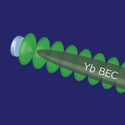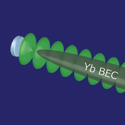Ups and downs in a BEC
Tuning the interatomic interactions in a Bose-Einstein condensate (BEC) has fundamental and applied interest, from the manipulation of ultracold molecules to the quantum simulation of Bose-novae and novel Hubbard models.
Scientists are able to smoothly tune the atomic interaction in a BEC from repulsive to attractive by creating what is called a Feshbach resonance between pairs of atoms. However, these resonances are typically tuned with a magnetic field and therefore affect all of the atoms in the condensate uniformly. Now, writing in Physical Review Letters, Rekishu Yamazaki, Shintaro Taie, Seiji Sugawa, and Yoshiro Takahashi at Kyoto University in Japan have used an optical approach to tune a Feshbach resonance that allows them to spatially modulate both the strength and sign of the interactions within the condensate.
Yamazaki et al. apply a pulsed optical lattice—a standing wave of light created by bouncing a pulsed laser from a mirror—to a condensate of ytterbium atoms. The standing wave, which is tuned to the vicinity of a photoassociation transition that mediates the Feshbach resonance, has a periodicity of and effectively modulates the interatomic interaction— in some cases from negative to positive—with the same periodicity.
This ability to quickly spatially modulate the scattering length in a BEC on submicron scales could enable a broad class of experiments in nonequilibrium BEC physics. – Manolis Antonoyiannakis





